Real Property Report - California, December 2015
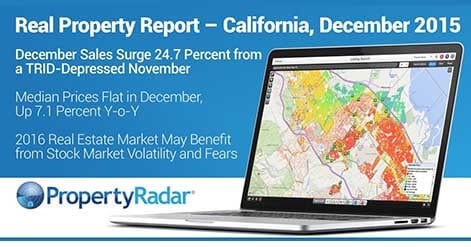
December Sales Surge 24.7 Percent from a TRID-Depressed November
Median Prices Flat in December, Up 7.1 Percent Y-o-Y
2016 Real Estate Market May Benefit from Stock Market Volatility and Fears
CALIFORNIA, JANUARY 19, 2016 – California single-family home and condominium sales were 33,969 in December 2015, up 24.7 percent, from a revised 27,241 in November. On a year-ago basis, sales were up 3.7 percent from 32,748 in December 2014.
“The new FED disclosure rules (TRID) that went into effect in early October are still impacting sales,” said Madeline Schnapp, Director of Economic Research for PropertyRadar. “The new paperwork requirements slowed the mortgage application process in November pushing sales into December. The artificial TRID disruption to November and December sales data will simply be an economic footnote by end of January.”
The December median price of a California home was $412,500, nearly unchanged from the revised November price of $412,000. Home prices have been trending mostly sideways since June and are just below the July 2015 peak of $415,000.
“Sales around the holidays are typically depressed so flat prices are not a surprise,” said Schnapp. “Affordability has become a significant issue in many coastal counties throughout the state but recent stock market volatility and fear may send investors scampering to the perceived safety of real estate, putting upward pressure on prices.”
In 17 of California’s 26 largest counties, December median prices were flat to lower than November’s. Counties with the largest price decreases were Contra Costa (-6.7 percent), San Francisco (-8.5 percent) and Santa Clara (-9.2 percent). Six of the nine Bay Area counties experienced lower median prices for the month.
“Like we said in our October 2015 report, 'Flat is the New Black,' this ho-hum low sales volume market will likely persist into 2016,” remarked Schnapp. “Despite lackluster sales, median prices may continue to grind higher due to low inventory and increased demand from investors looking for some sort of positive yield.”
On an annual basis, the median price was up 7.1 percent from $385,000 in December 2014. Annual price gains were five percent or more in 14 of California’s 26 largest counties. The counties with the largest annual price increases were Marin (+13.7 percent), Monterey (+16.6 percent), San Francisco (+11.1 percent) and San Mateo (+11.6 percent).
“Median prices rose sharply during the first half of the year but slowed in the last half of the year,” said Schnapp. “Sticker shock in the last half of the year combined with fear of a FED interest rate hike may have put a lid on demand.”
The number of homeowners in a negative equity position continued its downward trend in December. Negative equity decreased 0.2 percent, or approximately 14,000 in December. Approximately 6.5 percent of homeowners, or nearly 570,000, owed more than their home was worth. To put the current negative equity level in perspective, in January 2015 there were just under one million California homeowners underwater, or one in nine. Today, one in 15 California homeowners are underwater.
“The rise in prices is good news for underwater homeowners,” said Schnapp. “The sharp rise in median prices in early 2015 means half-million fewer California homeowners were underwater than in December 2014.”
December 2015 cash sales were up 1.1 percent from November. On a year-ago basis, cash sales were down 14.2 percent from December 2014.
“Cash sales as a percentage of total sales returned to normal in December after spiking in November,” said Schnapp. “The new FED TRID rules impacted the November data by delaying the recording of non-cash sales.”
Cash sales were 20.2 percent of total sales in line with the average of 20.7 percent over the past six months. Of the 26 largest counties in California, the counties with the highest percentage of cash sales were Merced (24.7 percent), Monterey (24.3 percent), Riverside (24.5 percent), San Luis Obispo (24.3 percent), and Santa Cruz (26 percent).
“Cash sales as a percentage of total sales remain historically high,” said Schnapp. “Despite high prices, real estate investing remains an attractive alternative in an interest rate constrained environment where other asset classes are losing favor.”
In other California housing news:
- Flip sales jumped 26.0 percent during the month of December and are up 19.2 percent over the past 12 months. Flip sales peaked in July, coincident with a peak in median prices. Flip sales typically jump in December as sellers push to close and record sales before the end of the year.
- Institutional Investor (LLC and LP entities) December purchases gained 13.4 percent to 1,256 for the month and were up 5.8 percent from December 2014. Despite December gains, institutional investor purchases are down 46.0 percent from their peak in December 2012.
- Trustee Sale purchases by LLC and LPs jumped 18.5 percent to 128 for the month and were up 33.3 percent from December 2014. Trustee sales were down 87.9 percent from their October 2012 peak but have trended mostly sideways since May 2014.
- Institutional Investor sales were up 28.9 percent for the month but were down 21.5 percent from December 2014. Investor sales have been on a downward trend since December 2012.
- Foreclosure Notices of Default and Notices of Trustee Sale reversed November losses and were up 11.8 percent and 14.8, respectively for the month. Both Notices of Default and Notices of Trustee Sale are near their lowest levels in our records dating back to January 2007.
Home Sales
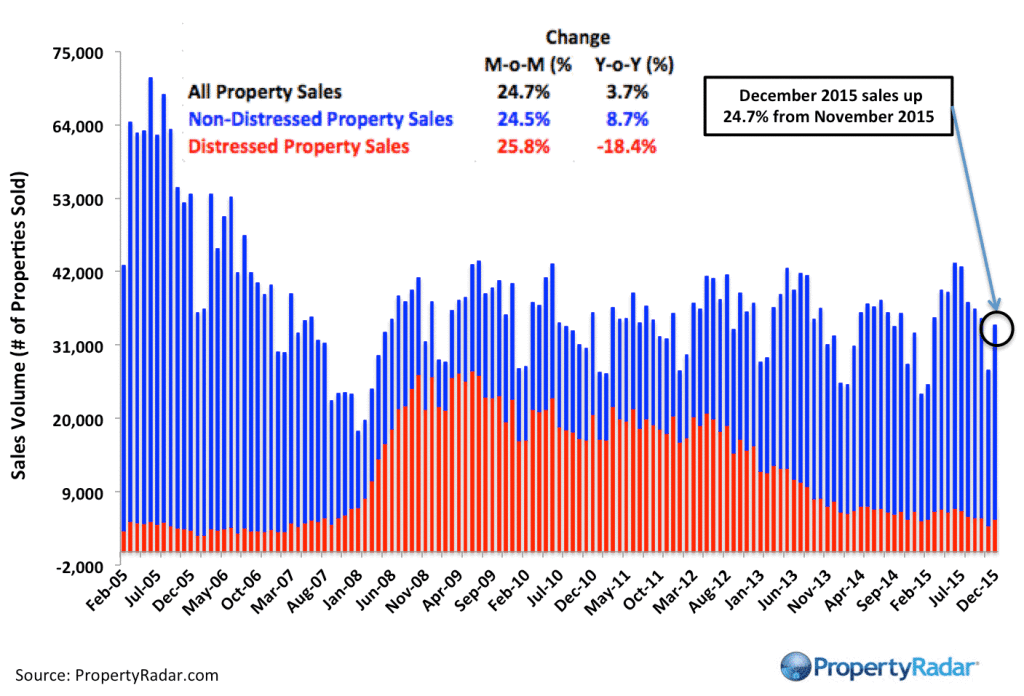
Home Sales - Single-family residence and condominium sales by month from 2007 to current divided into distressed and non-distressed sales. Distressed sales are the sum of short sales, where the home is sold for less than the amount owed, and REO sales, where banks resell homes that they took ownership of after foreclosure. All other sales are considered non-distressed.
Year-End Annual Sales Summary
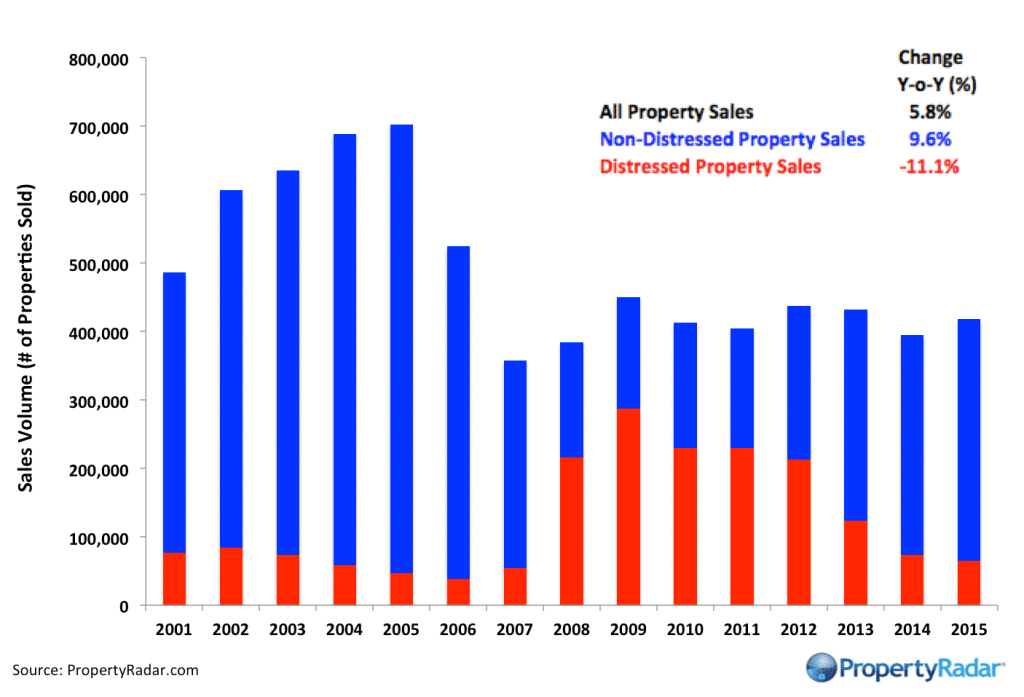
Year-End Annual Sales Summary - Annual single-family residence and condominium sales by year divided into distressed and non-distressed sales.
Year-over-Year Home Sales
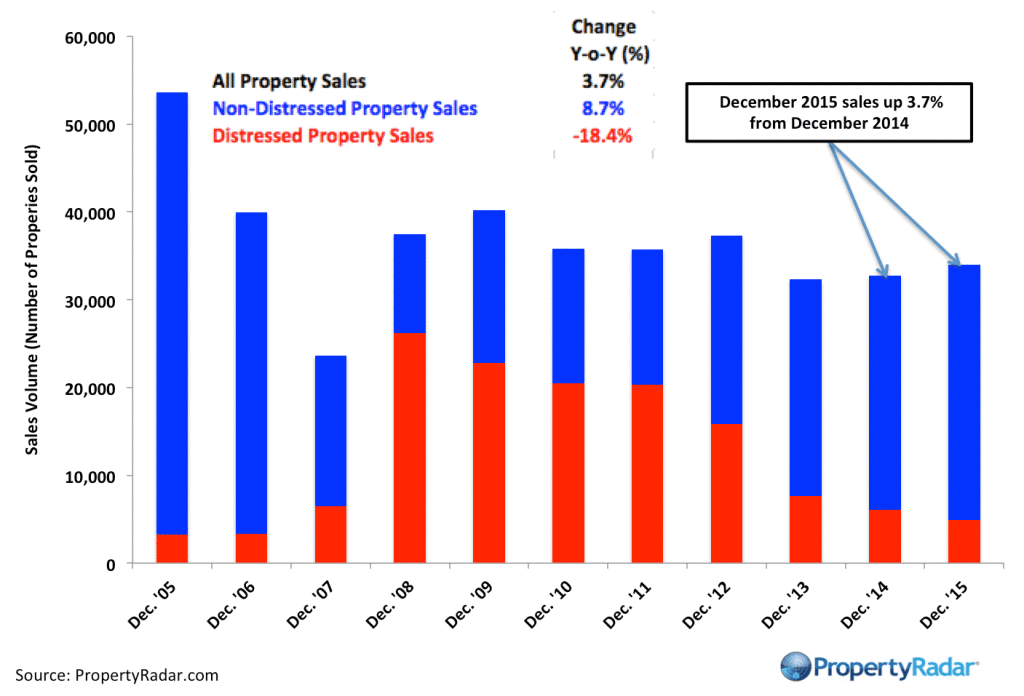
Year-over-Year Home Sales Year-over-Year Home Sales - Single-family residences and condominiums sold during the same month for the current year and prior years divided into distressed and non-distressed sales.
Median Sales Prices vs. Sales Volume
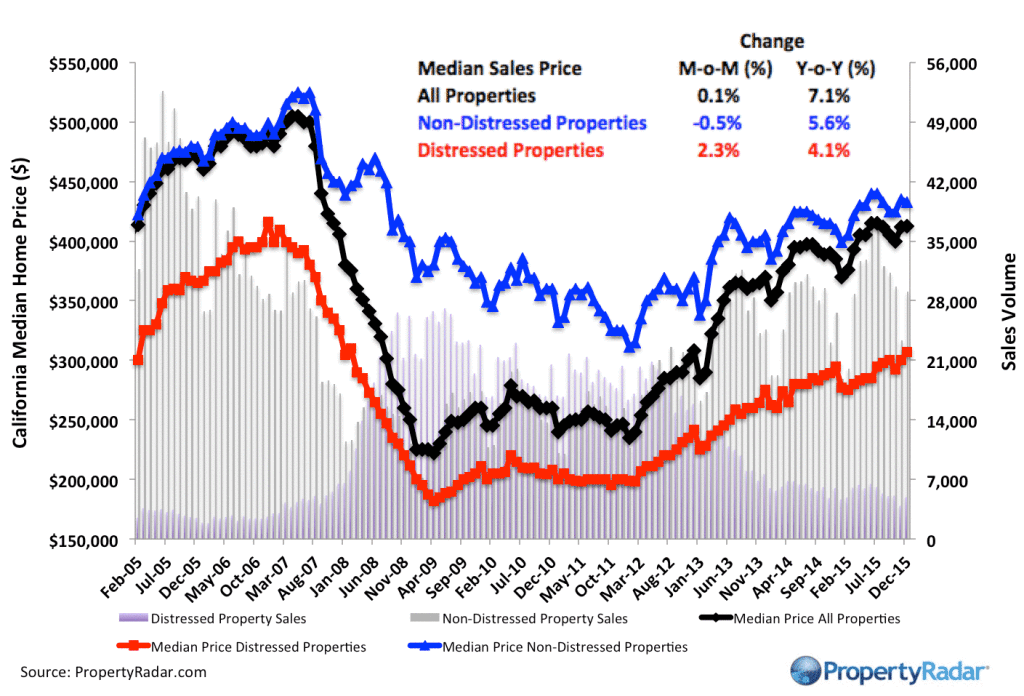
Median Sales Price vs. Sales Volume - Median sales price (left axis) of a California single family home versus sales volume (right axis), by month from 2012 to current. Median sales prices are divided into three categories: All single-family homes (black line), distressed properties (red line), and non-distressed properties (blue line). Monthly sales volumes (right axis) are illustrated as gray and lavender bars. The gray bars are distressed sales and the lavender bars are non-distressed sales.
California Homeowner Equity
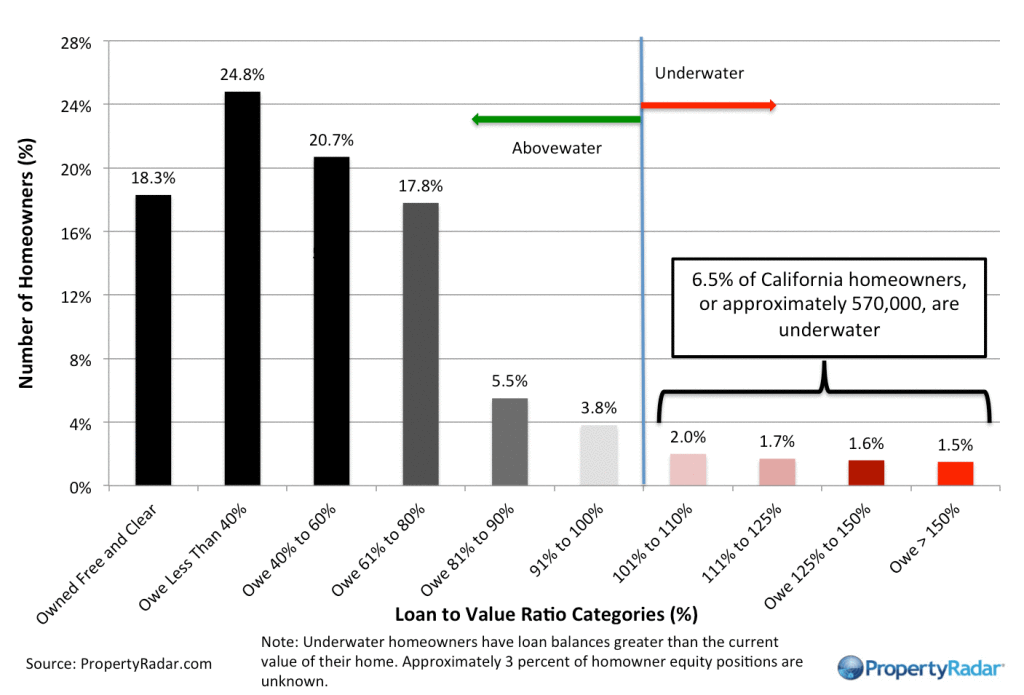
California Home Owner Equity - A model estimate of California homeowners segregated into various categories of levels of homeowner equity for a given month. Homeowner numbers represent a percentage of total California homeowners.
Cash Sales
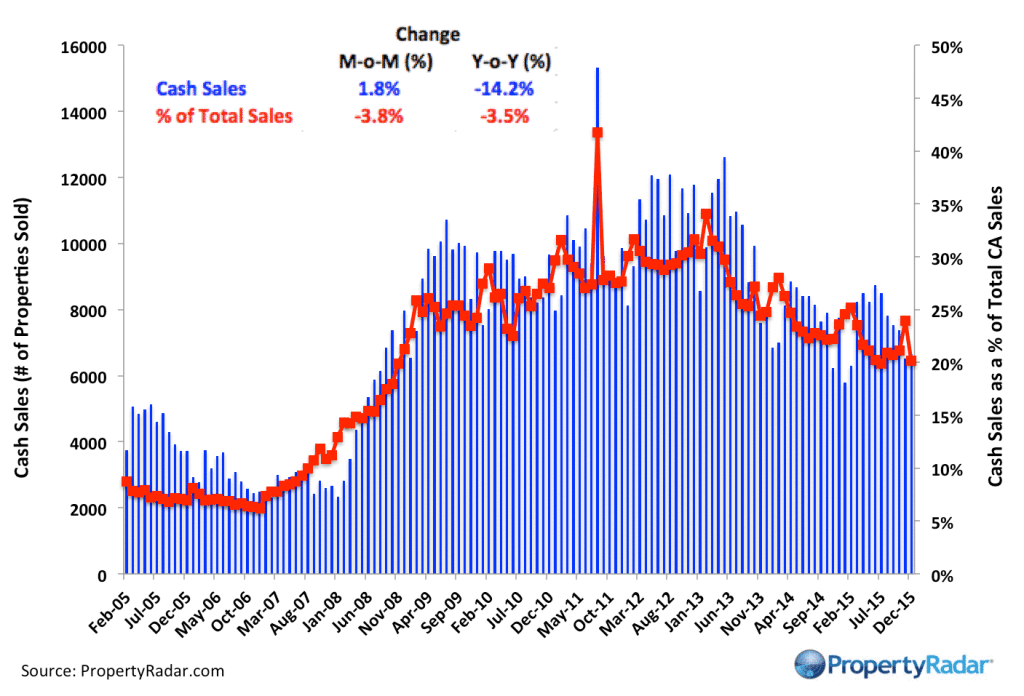
Cash Sales - The blue bars (right axis) illustrate cash sales of single-family residences and condominiums by month. The red line (left axis) illustrates cash sales as a percentage of total sales by month.
Flipping
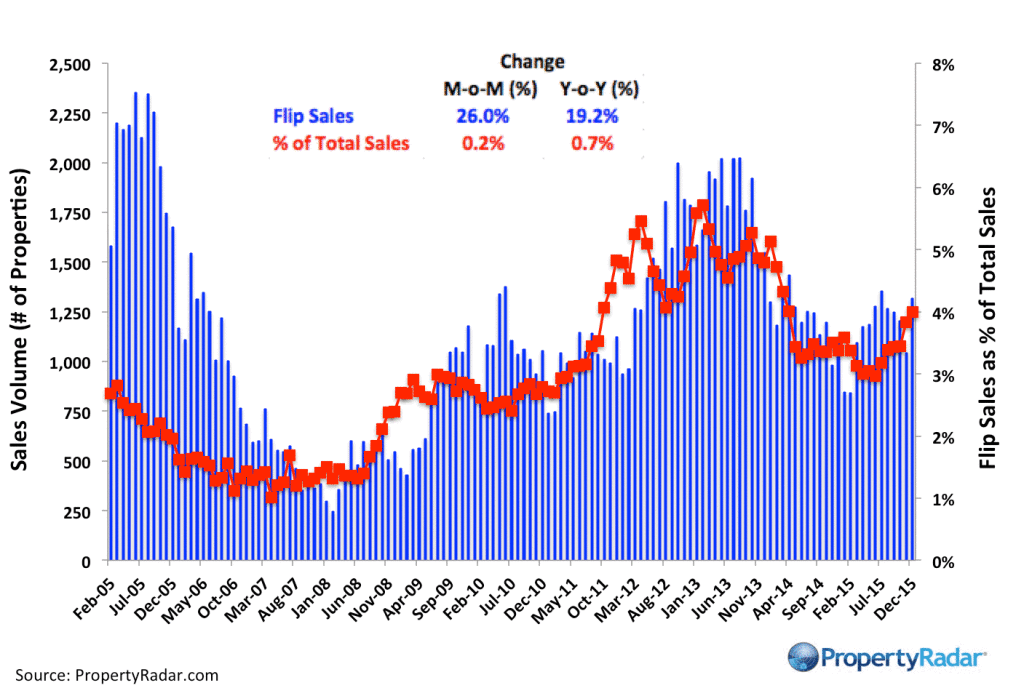
Flipping – The number of single-family residences and condominiums resold within six months.
Market Purchases by LLCs and LPs
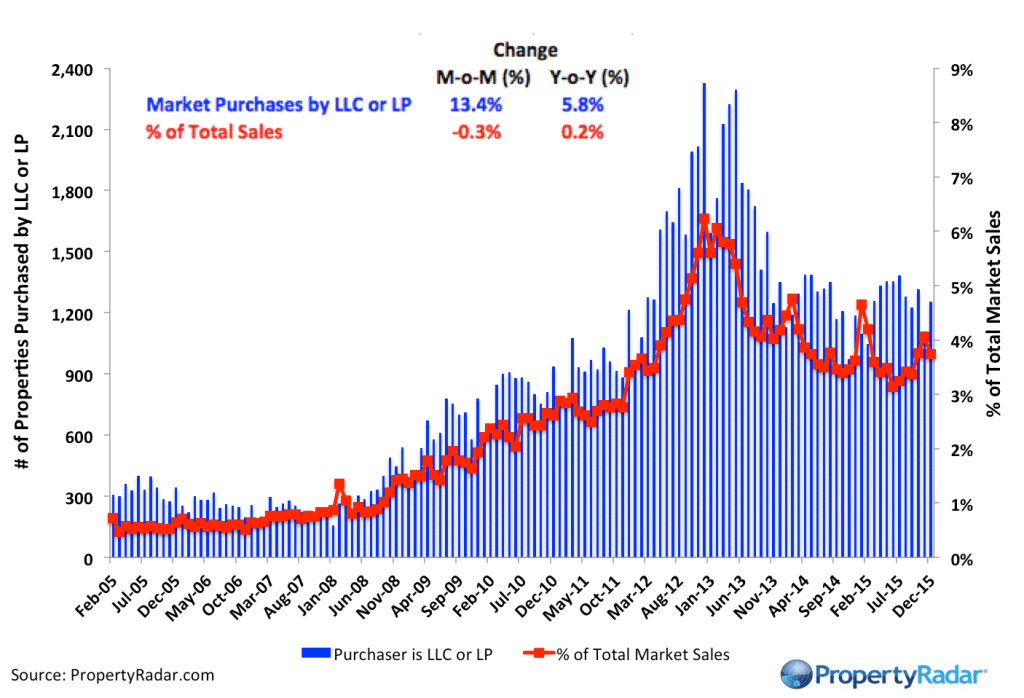
Market Purchases by LLCs and LPs - The blue bars (right axis) illustrate market purchases of single-family residences and condominiums by LLCs and LPs from 2007 to current. The red line graph (left axis) illustrates LLC and LP purchases as a percentage of total sales by month.
Market Sales by LLCs and LPs
Market Sales by LLCs and LPs - The blue bars (right axis) illustrate market sales by LLCs and LPs of single-family residences and condominiums by month. The red line graph (left axis) illustrates sales as a percentage of total sales by month.
Trustee Sale Purchases by LLCs and LPs
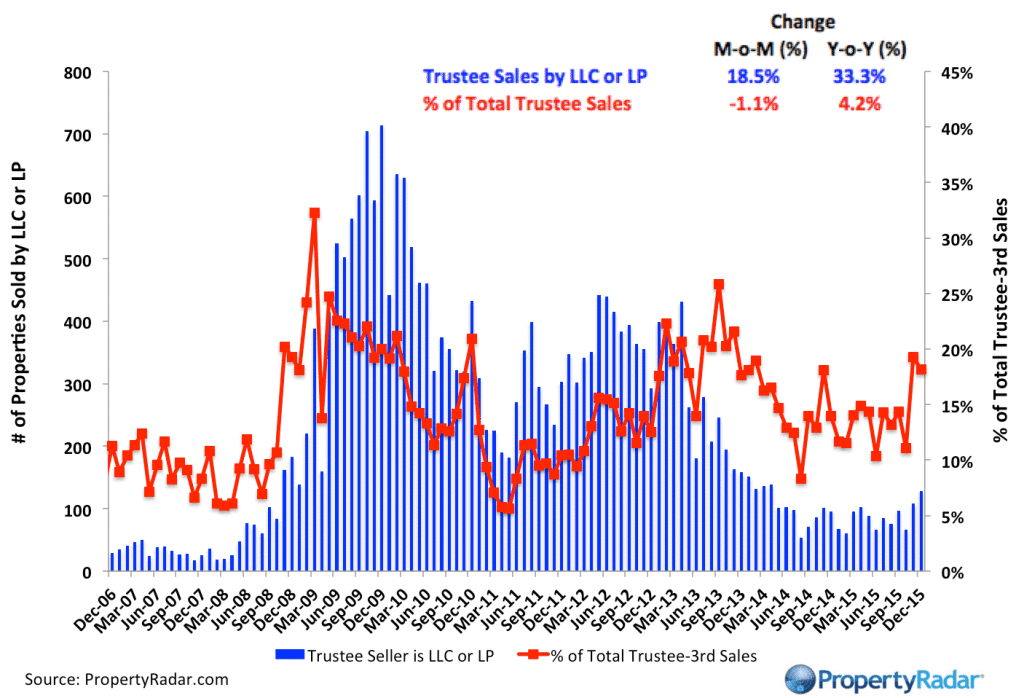
Trustee Sale Purchases by LLCs and LPs - The blue bars (right axis) illustrate trustee sale purchases (foreclosure sales) of single-family residences and condominiums by LLCs and LPs from 2007 to current. The red line graph (left axis) illustrates purchases as a percentage of total trustee sales by month.
Foreclosure Notices and Sales
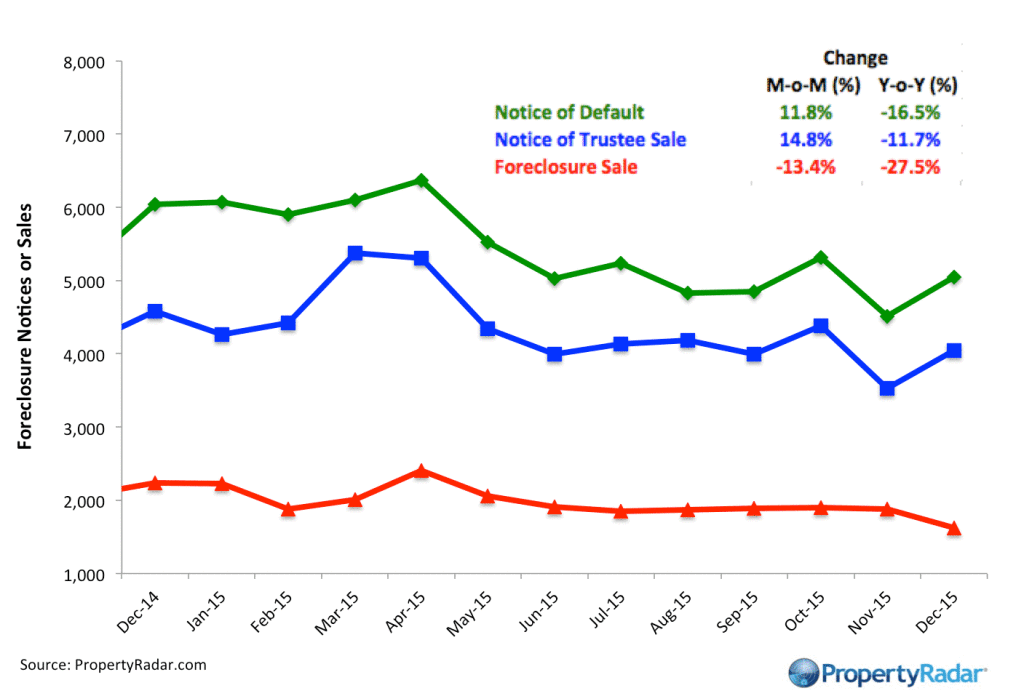
Foreclosure Notices and Sales - Properties that have received foreclosure notices — Notice of Default (green) or Notice of Trustee Sale (blue) — or have been sold at a foreclosure auction (red) by month.
Foreclosure Inventories
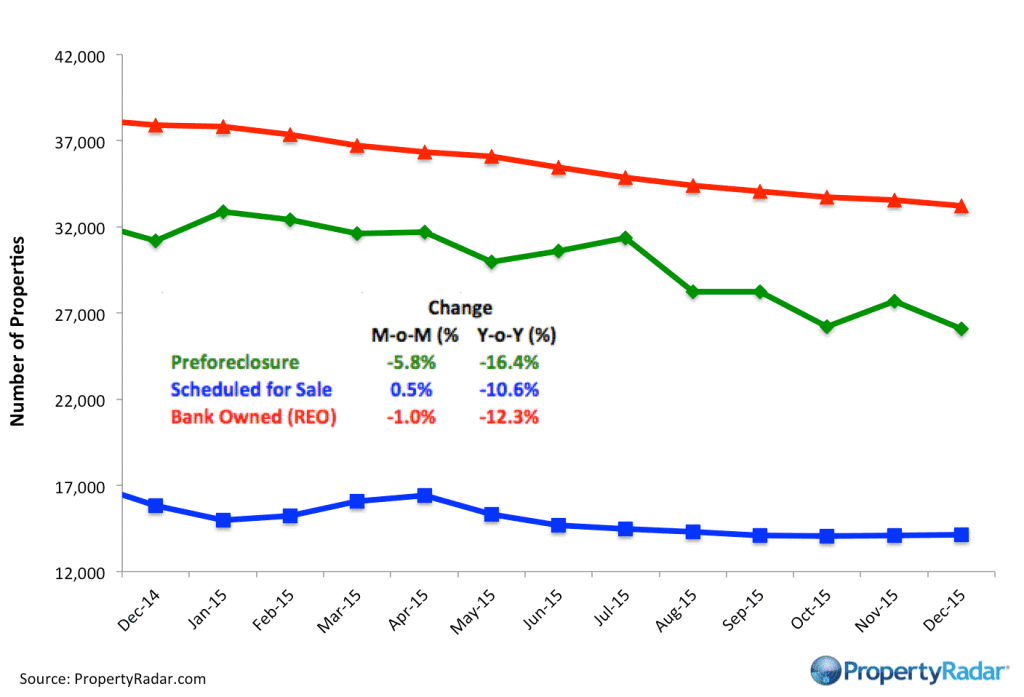
Foreclosure Inventory - Preforeclosure inventory estimates the number of properties that have had a Notice of Default filed against them but have not been Scheduled for Sale, by month. Scheduled for Sale inventory represents properties that have had a Notice of Trustee Sale filed but have not yet been sold or had the sale cancelled, by month. Bank-Owned (REO) inventory means properties sold Back to the Bank at the trustee sale and the bank has not resold to another party, by month.
Real Property Report Methodology
California real estate data presented by PropertyRadar, including analysis, charts and graphs, is based upon public county records and daily trustee sale (foreclosure auction) results. Items are reported as of the date the event occurred or was recorded with the California County. If a county has not reported complete data by the publication date, we may estimate the missing data, though only if the missing data is believed to be 10 percent or less.


